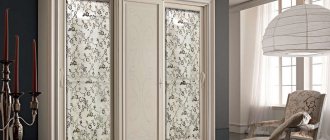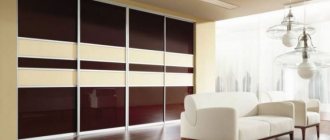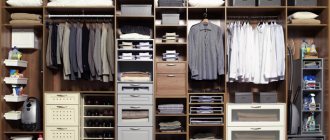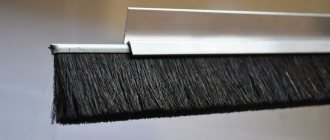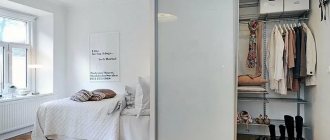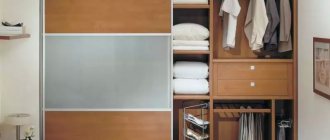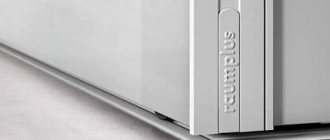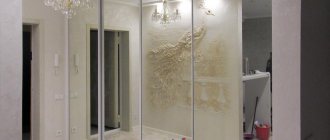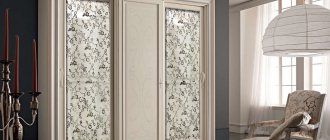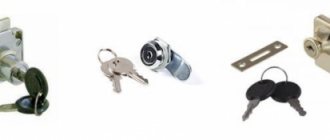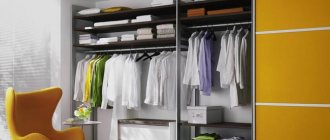9750 0 0
Merlin June 22, 2018
The capacity of the cabinet depends on the correct placement of the shelves.
The capacity of the closet depends on the layout of the interior space. Properly installed shelves accommodate 60–70% of the contents. Let's look at the rules for arranging a closet.
Efficient use of space
The sliding wardrobe is popular due to its spaciousness and the ability to combine internal modules. The distribution of the filling depends on the purpose/location of the furniture. Before purchasing, you need to know what will be stored on the shelves and properly plan the interior of the cabinet.
Approximate distribution of shelves in a two-door cabinet 60 cm deep
It is important to understand the principle of distribution of internal space - this will make planning easier. Any closet is divided into three zones: upper, middle, lower. Based on this, the internal parts are arranged.
There are no specific standards for the arrangement of accessories inside the cabinet. The design of the filling depends on a combination of factors: the number of family members, location, purpose, as well as on the lifestyle, habits and growth of the owners.
Pull-out mechanisms for shelves and baskets are very convenient
| Photo | Description |
| Upper space distribution The upper part is called mezzanines. It can start at 180 cm and end at the ceiling of a room that is 220 cm or more up to 320. The significant height creates difficulties in using this space. Rarely used items are stored in the mezzanine compartment. The top of the cabinet is usually 40–60 cm high. Large items can be placed here: suitcases, bags with seasonal clothes, blankets, etc. There are no shelves in the mezzanine, but if you plan to store boxes and non-bulky items, then you can make one shelf or pull-out baskets for small items. | |
| Middle part distribution The most user-friendly is the middle. It occupies about 50% of the total space, here everything is before your eyes and accessible. In the middle part there are niches for hangers and shelves. | |
| Bottom distribution The height of the lower compartment ranges from 40 to 70 cm. The filling can be different: shelves, pull-out mesh baskets and drawers. The main purpose is shoes and small things. |
Tips for choosing
You need to select components for sliding wardrobes based on the quality of the parts. The rigidity of metal products, as well as the smoothness and softness of the roller systems, determine the durability and ease of use of a piece of furniture. Door hardware must withstand daily loads, so you should not purchase cheap models. It is important that the internal content is properly planned. It is necessary to pay attention to the material of manufacture of all components. You should also consider the following recommendations:
- the size of the guides must correspond to the dimensions of the cabinet and the length of the doors;
- the rollers must ensure smooth and silent running;
- closers need to be chosen that will easily withstand the weight of the door leaf;
- sealants should not shrink or leave marks on the surface.
When choosing the main components, you need to pay attention not only to the quality of the material, but also to the reputation of the manufacturer. The design will last a long time if the components are selected in accordance with the dimensions of the product. You also need to know the rules for operating sliding wardrobes.
A sliding wardrobe is a universal piece of furniture in which you can store a huge number of things. It fits well into any interior and also helps to divide the space into zones. The correct choice of model will allow you to implement even the most complex project.
Purpose of profiles for sliding wardrobes, overview of varieties
The size of the guides must correspond to the dimensions of the facade
It is better to choose silent rollers
Closers must be able to withstand the weight of the door leaf
It is important that the seal does not shrink
Selecting fillers and accessories
Devices and their correct location help to effectively use the internal volume of the wardrobe. Accessories for organization are selected according to the size of the wardrobe, the number of sections and items.
Pull-out belt/tie holders and slatted shelves provide convenient storage
A standard wardrobe has pull-out shelves, a compartment for hangers, and drawers. Depending on the availability of space, additional sections are created in the form of shelves and strips. They are divided according to their specific purpose:
- skirts,
- shirts,
- belts,
- trousers,
- ties,
- hats.
Such departments can be stationary or mobile. Mechanical devices make things more accessible and help rationally use space.
Shelves, hanging rods, drawers, mechanical fixtures are called cabinet hardware. Let's look at the most necessary ones.
Detailed description of fittings placement
Hangers and crossbars
It is customary to store wrinkled clothes on hangers. In the wardrobe, separate sections with crossbars for hangers are allocated for this purpose; they are placed horizontally in two ways: along the length of the wardrobe or perpendicularly.
- The first option is possible with a cabinet depth of 60 cm. A crossbar located along the cabinet saves space, helps to fit more clothes and allows you to see all the contents at once.
- Perpendicular or end placement, used in shallow cabinets 40–45 cm. This is a less convenient option, in which only the first hanger is visible. A retractable mechanism is often used for the end bracket.
Crossbars/brackets are usually located in the middle part. An unconventional arrangement is also possible - a pantograph. This crossbar lowering device allows the top of the cabinet to be used for hangers.
The mechanism has a handle with which the bar with hangers extends and lowers to a convenient level.
Three-section cabinet. Hangers occupy one section, the top one is equipped with a pantograph
The pantograph is mounted during assembly; if you want to install it in an existing wardrobe, you need to buy a device according to the section size or adjust the internal partitions to the mechanism.
Shelves and drawers
There are no cabinets without shelves and drawers - this is a necessary attribute of filling. Their sizes depend on what you are going to store, so they are arranged differently. The minimum gap between the shelves is 30 cm. The width and depth depend on the section in which they are located.
The boxes can be solid, laminated chipboard, or breathable, made of metal/plastic mesh. Mesh options allow you to see the contents and provide air access to things.
Mesh drawers are recommended for storing wool sweaters, bedding and bath items
In radius and corner cabinets, it is recommended to use movable, rotating devices and wardrobe elevators. These devices provide access to deep storage areas.
Terminology - Cabinet Making
Mezzanines are small lockers. They are installed on ordinary wardrobes. To do this, the room must have high ceilings.
The attic is a wall located above the cornice and is the completion of the facade, in rare cases recessed in relation to its plane.
An insert is what is used to fill a wardrobe door (chipboard, mirror, etc.). Combinations of different materials are possible.
A tie holder is a product shaped like a staple or other shape that is usually attached to the back of a swing door and is designed for hanging and storing ties.
The door system is a complex of guides, profiles and wheels. They are components of doors and wardrobes.
Fibreboard is a sheet material that is produced by hot compression of a mass of wood fibers. In order to increase the performance properties, hardening agents, water repellents (ceresin, paraffin), antiseptics, etc. are added to the mass. Fibreboard serves as raw material for structural elements of furniture, the bottom shelves of sofas, shelves of cabinets and the back walls of cabinets and cabinets, partitions, headboards, drawers. They are also used for the production of bent-glued parts with outer layers made of sliced veneer of valuable species. Sometimes hard fiberboard is called hardboard. In rare cases, in sliding wardrobes the back wall is made of fiberboard.
Chipboard is a chipboard made from pressed wood shavings and sawdust, which are impregnated with a binder (formaldehyde resin). Chipboard is used in the production of laminated chipboard, often used in the manufacture of sliding wardrobes.
The back wall is a thin sheet of chipboard (8 mm) that covers the back of the wardrobe. It is attached between the side panels of the wardrobe or to the wall.
Mirror doors - for their production in wardrobes, mirrors with a protective film are used. Non-tempered glass is used for their production. This is necessary so that the mirror does not suffer if the door bends significantly. Mirror canvases are produced both regular - silver, and tinted - bronze, etc.
The edging is a strong plastic tape with a width of 16, 18 or 25 mm. The edging serves as protection against moisture and various external influences for the side surfaces of the wardrobe panels.
Laminating is the lining of a wood board with a polymer film or paper-resin film with high resin condensation and subsequent application of a layer of varnish or paint. The film is attached to the slab thanks to glue, which is applied to the slab or film during cladding.
A cornice is a linear element of a building that completes it or a piece of furniture. It is built on the basis of any profile or combination of a number of profiles. The highest element of the cornice most often protrudes above the rest. At the same time, it has maximum reach. Above the cornice there may be a pediment or attic.
Cassette - translated from French as box. In furniture, this is a row of trays located above each other, which are united by common sidewalls. They are hung on the back of a swing door and small items and things are stored in them.
A cap is a monolithic unit, the top of a cabinet or other separately located element of cabinet furniture, which has the shape of a box, includes a cornice and other architectural details, as well as a horizontal wall.
The visor is a decorative panel that protrudes above the roof of the wardrobe. If the customer wishes, it is possible to install lighting in it.
Laminate is a covering that has many layers, consisting of a decorative paper layer and a layer of melamine resin. In addition to its decorative function, it imparts high strength to the furniture surface. This material is resistant to shock, moisture and high temperature. Used for the production of laminated chipboard, often used in the production of sliding wardrobes.
Laminated chipboard is a board that has a protective coating of unique decorative paper, which is impregnated with melamine resins. Laminated board (melamine board) is resistant to high temperature and moisture, resistant to abrasion and other damage. Laminated board is used in the production of laminated chipboard, which is used in the assembly of sliding wardrobes.
Solid wood is furniture made from panels that are glued together from wooden blocks.
Fine fraction (MDF) is a board made from tiny sawdust that is pressed under high pressure. According to its parameters, MDF board has higher strength, moisture resistance, a high thickness range and wider prospects for decorative processing in comparison with chipboard. MDF is produced by dry compression of fine wood chips. This is achieved by high pressure and temperature. Perfectly processed. It is most often used for facade elements, in rare cases for furniture frames. MDF is most often used in kitchen cabinetry because it is resistant to kitchen steam. In wardrobes they are used in the manufacture of swing doors.
Melamine is a decorative, moisture-resistant coating that is not susceptible to mechanical damage.
A dead zone is a certain area of the wardrobe that causes discomfort (when the doors of the wardrobe are opened, the drawer that pulls out touches the door, or does not pull out at all).
Sliding wardrobe guides are rails; sliding doors move along them.
Natural rattan is the rattan palm, which is a tropical vine. Palm wood consists of a three-layer structure and has a fairly strong bark. Its middle layer is quite porous and soft, and the core is very hard. The high demand for rattan furniture has led to the fact that manufacturers of sliding wardrobes are increasingly using decorative inserts made from rattan in furniture production.
A bumper is a narrow panel that is used in openings between the walls of a room. The bumper makes the design of the wardrobe cheaper, but does not affect its quality. When the wardrobe doors are closed, the design appears to have side panels. Most often, the bumper serves as decoration.
PVC is polyvinyl chloride, a synthetic material. This is a highly durable, economical and versatile material. In addition, it is considered environmentally friendly. In the manufacture of sliding wardrobes it is used for finishing edges and cladding facades.
The underlay is a narrow panel that is designed to extend the life of the bottom track of the wardrobe. It is located directly under the bottom track (if the floor covering is carpet or tiles, or it has an uneven surface).
The positioner is a steel bracket that is attached to the bottom track of the wardrobe. Used to secure doors in the desired location of the wardrobe. This part is used in the Raumplus system.
Shelf for hats - it is used to store hats in the closet.
A runner is a pair of horizontal bars or strips that are attached to the vertical walls of the product. They serve to hold trays, shelves, half-drawers or drawers in the desired position and to slide them out. The runners are made from plastic or wood.
A half-drawer is a drawer that is located inside a piece of cabinet furniture and is absolutely invisible behind its facade (door). The height of the front wall of the half-box is less than the height of its walls.
Profile - horizontal or vertical frame. In some types of wardrobes, the profile can be manual. The profile differs in material, color and shape. In the wardrobe system it is possible to use both aluminum and steel profiles. Frame, frame is a part of the wall of a product or door, which consists of 4 or more bars with corner joints. The plug is installed in the form of a panel, or glass inside the frame.
The wall is all the sides of the furniture body, including the outer vertical and horizontal parts that are located in its middle. Thus, the walls are divided into horizontal, middle and side.
A tie is an element that connects furniture parts, which ensures the creation of the force necessary to ensure the strength of the unit or product under the influence of external and internal loads and forces. The layout is a decoration that has a self-adhesive base.
Honeycomb frames are baskets, shelves and other elements made of high quality structural steel. They are covered with an environmentally friendly polymer coating. They are used to fill the wardrobe.
The stopper is a plastic element that prevents the closet door from moving along the entire length of the track.
Texture - this word comes from the Latin word textura and means - connection, fabric, structure, connection. The nature of the surface of any material, which is caused by its internal structure, structure. Texture can be perceived both visually and tactilely. A longitudinal section of a tree shows its fibrous structure, and a cross section shows the growth structure (finished rings). Texture is caused by the chemical and physical qualities of the material and is thus significantly different from texture, which depends almost entirely on the originality of the artist who creates it.
Embossing - when used, a relief print is produced. The material is distorted by the high pressure between the negative and positive rollers.
The track is a guide; wardrobe doors move along it. The track can be lower or upper. Tracks made of steel are used in Indeco sliding wardrobes, and aluminum tracks are used in Raumplus sliding wardrobes.
A false panel is a decorative plate made of chipboard, which is used to increase the height of a wardrobe and hide voids. It is identical in color and texture to the door trim.
Facade - the front part of the furniture. Often, sets produced by the same factory may differ from each other only in the design of the facade, while the cabinet bodies are identical.
Panel is a thin finishing plywood or board with a convex pattern. It is inserted into the frame of the wardrobe door.
The pediment completes the architectural structure; it is a triangular plane formed by the cornice and roof slopes.
Fittings are latches, handles, locking products and other devices that ensure the opening of the valves, their fastening in the installed position or locking.
A base is a decorative strip that covers the legs of cabinets. It can also be a support bar; a wardrobe is placed on it. In kitchens, the base is most often easily removable and made of plastic. The base can also decorate an architectural structure.
A sliding wardrobe is a way of opening doors. The doors move apart along special guides.
A wardrobe (for dresses and linen, wardrobe) is a combined wardrobe in which linen and dresses are stored. Its design allows you to combine special storage units of different functional significance in one product: compartments for linen, clothes, hats, and so on.
Wardrobe Slavyanovskiy (Slavic) is an outdated name for a combined wardrobe for linen and dresses. This type of cabinet was very popular in the first half of the 20th century. The cabinet was named after the manufacturer Slavyanov. Its distinctive features are a wide compartment with one door, on the right with a bar for hangers with clothes behind a door with a mirror, and a not so wide compartment on the left, with shelves and retractable half-drawers behind the door with a “window” in the form of a decorative composition made of beveled glass . They are assembled together using a brass profile. The completion of the cabinet was a cap made of wide bars, sometimes with carvings on all three facades. Under all the doors, in the base of the cabinet there were two drawers. Occasionally, a Slavic cabinet was called Slavic.
A rod is a metal or wooden rod (pipe) that is installed behind the doors, directly in the closet, most often parallel to the facade, under the hat shelf, in which clothes are stored on hangers.
The stiffener shield is a cabinet part. It is otherwise called the posterior wall. It absorbs all lateral loads when using the product.
Schlegel is a shock absorber seal. The fluffy brushes have a thickness of 5 mm (shock absorbers) and 10 mm (anti-dust). They are glued to the doors of the wardrobe.
A drawer is a product unit that has the shape of a box. It stores linen, shoes and other items. To slide out of the housing, the product must be installed on slides or guides. The front front wall of the drawer is an integral part of the facade.
Compact Storage Accessories
Modern sliding wardrobes are spacious and as comfortable as possible, as they are equipped with mechanisms. Before purchasing or ordering a cabinet, you need to have an idea of the most necessary and efficient storage devices:
| Photo | Description |
| Organizer boxes They have dividing inserts and divide the internal volume into cells. They are convenient for storing small things and items. The height of organizer boxes starts from 10 cm. Along with ordinary drawers, it is useful to have one or two such organizers. | |
| Bars for hangers They can be located in the depths of corner structures or in the mezzanine compartment. For this purpose, lifting and lowering pantographs with a rotating mechanism are used. | |
| Pull-out hangers Attached to the end wall - for ties, belts, scarves/kerchiefs. The device consists of a bar with hooks or a retractable mini-bar. A small space is required (8–15 cm), so installation is carried out in the hanger section. | |
| Withdrawable, rotating modules Used for skirts, shirts, trousers. May have a compartment for hangers. The optimal location is at chest/eye level. | |
| Multi-tiered pull-out baskets Purchased instead of a regular shoe rack. Mesh shelves for shoes/boots are located at an angle. This lowers the heels into the holes in the mesh, freeing up space for other shoes. |
Interior design and examples
Having decided on the installation location, you know approximately what will be stored in the closet. Let's look at examples of furniture filling.
Proper arrangement of the “filling” allows you to maintain order and creates comfort in use. Things are stored compactly and in their place. When you open the door, you can easily navigate inside the closet and quickly find the desired item of clothing.
Stationary crossbars can also be located in the lower part
Large three-meter closet with narrow and wide shelves
Pantograph, shoe rack, tie and belt racks, numerous drawers
Options for filling a wardrobe for a bedroom
The wardrobe installed in the bedroom is designed to store bedding and everyday clothes. The depth of such a cabinet is chosen to be 60 cm, which allows you to install longitudinal rods for clothes and increase capacity.
The standard content contains the following accessories:
- pantograph in the mezzanine compartment;
- shelves are installed from plastic/metal (provide air circulation, laundry is always fresh);
- retractable baskets;
- stationary crossbar;
- end retractable bar for shirts;
- retractable trouser;
- multi-level baskets with a sliding mechanism;
- crossbars/brackets for belts, ties;
- hidden ironing board (pull-out mechanical), with iron holder.
The mezzanine in the bedroom is intended for storing guest sets of linen, blankets, spare pillows, blankets
Things stored in the mezzanine are voluminous, so the upper part is not equipped with shelves. If the dimensions of the closet allow, then a dressing table with a mirror and a hairdryer is built in.
A lot of linen is stored in the closet in the bedroom; it needs to be kept clean. Dust protection is provided by dustproof door stickers.
Sliding wardrobe in the hallway: main characteristics
The layout of the closet in the hallway depends on the design. If the room allows, then install a spacious corner closet. More often, a modular closet with an open hanger, a mirror and a shoe cabinet with a seat is chosen for the entrance area.
An example of filling a closet in the hallway with dimensions
Outerwear, shoes, hats, scarves, and umbrellas are stored in the hallway, so the contents should be complete, with numerous shelves. It is more convenient to put small things in boxes 15–20 cm high or in organizers.
More space should be allocated for crossbars with hangers. If the cabinet is 45 cm deep and end retractable crossbars are installed in it. For a family of 3 people you need two crossbars; they will fit parallel in a meter compartment.
You can store a vacuum cleaner and apartment cleaning products in a closet installed in the hallway.
At the bottom there are wire sloping shelves for casual shoes. Seasonal - stored in boxes on mezzanines. A roll-out box for keys and a roller/brush for cleaning clothes is installed in the middle zone. Space is allocated for shoe care products.
For half-shirts, sweaters, jumpers, and wrinkle-resistant jackets, shelves made of laminated chipboard stand out. A pair of hooks for bags are mounted on the wall. For convenience, a retractable seat is made, one door has a mirror, preferably at full height, so that you can look at your full height.
There is no natural light in the corridor, so in addition to the ceiling chandelier, LED lighting is installed on the cornice of the cabinet.
The mirror can be installed in a niche with mandatory lighting
Wardrobe components for a children's room
The closet in the nursery should be filled for its intended purpose.
The children's closet is made multifunctional. It stores everything a child needs: clothes, linen, toys, books. The internal structure must be accessible to the baby and properly organized in order to teach him to maintain order.
Modular option with open shelves - the best option for a child
For a preschooler you will need a toy box, a shelf for crafts and creativity. Consider a convenient storage height:
- paints;
- plasticine;
- colored pencils;
- albums
- brushes;
- colored paper.
For schoolchildren, a mandatory shelf is allocated for textbooks, pencil cases and other school supplies.
Drawers may not be closed by doors
The components for a children's wardrobe differ little from a regular wardrobe. Charming accessories:
- hanger bars;
- boxes;
- baskets;
- shelves.
The space is divided into areas for clothes, toys, bedding, educational supplies and creativity. Be sure to use a box with dividers for small items.
If the size of the closet allows, make an area for sports equipment: balls, rollers, tennis rackets. Winter equipment (slides, skis) can be kept on the mezzanine.
The location of the zones must correspond to the height of the child. For convenience, internal lighting is installed. It is advisable to equip drawers with closers.
Corner wardrobe
The main advantage of corner cabinets is their spaciousness. Along with this, there is a problem with the arrangement.
A “dead zone” is formed in the corner. When choosing fittings, you need to take this point into account and install mechanisms in hard-to-reach places: rotating shelves and rotating crossbars.
Filling a built-in corner cabinet
The standard set of accessories contains:
- boxes;
- rotating racks;
- baskets;
- pantograph;
- lattice shelves;
- regular shelves;
- special rods.
The number of accessories is selected based on the design of the furniture, its size and the expected list of items for storage. If possible, shelves are equipped with escalator bases.
There is a rotating multi-tiered hanger rack in the corner
The corner closet contains compartments without shelves. It is convenient to place non-standard items in them: alpine skis, cane umbrellas, trekking poles, clubs, etc. You can store a vacuum cleaner in the depths, and a hose holder is mounted on the wall.
Types of components
The quality of components for sliding wardrobes must be high. Each part performs its functions and is selected in accordance with the content and dimensions of this type of furniture. Homemade elements will lead to a reduction in the service life of products.
Sliding systems
Parts of sliding systems can be purchased separately, and sets are also available. They can be supported or suspended. The first version of sliding systems includes rollers with two guides and a profile for the frame. It is easy to install and has a high level of reliability. This type of sliding system is used if the doors are heavy. Hanging fittings consist of an upper guide, rollers, and stoppers. The profile is fixed on the top cover of the housing or attached directly to the ceiling.
How to fit a classic-style wardrobe into the interior, tips
The wardrobe includes connecting elements and plugs. As for the materials for making profiles for door panels, it can be aluminum, plastic, steel. Each material has its own characteristics.
| Material | Characteristic |
| Aluminum | Mainly used for making rail supports. Such components are used most often, as they are practical, reliable and characterized by a long service life. |
| Plastic | This profile has a low cost, but its strength is not too high. It can be combined with a metal edging, which enhances the technical characteristics |
| Steel | Such door frames are characterized by high strength and durability. The cost of the material depends on the reputation of the manufacturer and may be deliberately inflated |
Aluminum profiles for door leaves are used even in large-sized structures. When choosing any component, you should not resort to the cheapest option, otherwise the cabinet will quickly stop functioning.
Aluminum
Plastic
Steel
Rollers
Rollers are a structural element that ensures the movement of wardrobe doors. They do not allow the canvas to slide along the guide without permission, and also facilitate the process of opening and closing. The movements are smooth and almost silent. Roller rims are made of plastic, rubber, Teflon or steel.
When used correctly, these elements can last for many years, since they are designed in such a way that dust does not get inside the mechanism. One way or another, in the event of a breakdown, installing new rollers for the wardrobe with your own hands will not be difficult at all. Thanks to this component, it is possible to adjust the position and height of the door leaves. The number of wheels is determined by the weight of the doors.
Rollers can be asymmetrical or symmetrical. The first option is used to move the door leaf along the lower guide profile. The second is characterized by fastening wheels on the lower and upper sides. It is intended for glass, mirror or plastic panels.
Asymmetrical
Symmetrical
Sealant
The seal is necessary to hide the gaps between the door leaf and the frame. It is attached to the side of the doors, ensuring a tight fit to the body. There are several types of products:
- Universal. Used when installing heavy doors.
- Silicone. This seal is not hazardous to health and ensures reliable fixation of the sashes in the profile frame.
- Brush. It consists of pile attached to adhesive tape.
Methods for repairing wardrobes, step-by-step instructions, recommendations
The width of the seal depends on the type of canvas and varies between 4–8 mm. The element comes with or without a self-adhesive base.
Universal
Silicone
Brush
Stopper and separator
The separator is more often used in designer models. It is made of glass, chipboard. The thickness of this fragment varies. A stopper is a component that secures the wardrobe door leaf in the right place, usually made of steel. The product has the shape of antennae and has high springy properties. The part must be installed in the lower guide profile.
Stopper
Delimiter
Retractable structures
The internal content of the wardrobe depends on how functional the furniture should be. Most often it is represented by retractable elements, for the use of which the following guides are installed:
- Roller. This type is the most common, but has a serious drawback - the elements are pulled out partially or completely. The maximum permissible load is 25 kg.
- Ball. There are small balls inside the profile, which ensure easy sliding of shelves or drawers.
- Tandems. The guides in this case are hidden inside the drawer. This system allows you to effectively use the entire internal space of the cabinet. It is expensive, but operates smoothly and silently.
- Metaboxes. In addition to guides, they include sidewalls made of plastic or metal. There are options that are put forward partially or completely. The height of the walls and the depth of the box may vary.
What accessories will be used depends on the financial capabilities of the people. Among the wide variety of elements, you can always find exactly what is suitable for a specific product model.
Roller
Ball
Tandem
Metabox
Additional items
It will be useful to supplement the furniture set with some practical details. A mezzanine for storing things that do not require constant access would not be superfluous. In addition, the cabinet may contain the following additional components:
- Shelves. There are retractable or fixed ones. The distance between them is about 30 cm. The first type is more convenient to use, but costs more.
- Drawers. A popular option is the full extension system, which provides easy access to everything. The height of the drawers is usually 20–30 cm. They are intended for laying out clothes that do not wrinkle.
- Barbells. They are used to store things on hangers or hangers.
- Pantograph. This is a device that extends the bar with clothes to a convenient level at a large height of the structure. The product can be mechanical or electrical.
- Shoe racks. They are mobile and mounted at the bottom of the wardrobe at a certain angle.
- Baskets. Most often they are retractable.
An additional element can be considered a crossbar to which hangers cling. It can also be fixed or retractable. In addition, the closet has a structure for storing ties, belts, and small items.
Shelves
Drawers
Barbell
Pantograph
Shoe rack
Baskets
What and how to store
Each item requires certain conditions for placement. In the design of the cabinet you need to be able to navigate and determine the right place for each item.
Baskets, plastic boxes, pull-out shelves - convenient devices for storing things
Rarely used items are stored in the mezzanines: suitcases, curtains, blankets, tablecloths, rugs, etc. Smaller textiles, towels, T-shirts, linen are stored in piles or rolled up. They use boxes, boxes, baskets.
Bags are placed on shelves or hung on brackets/hooks. Tights, socks, and underwear are folded and placed in a drawer with compartments.
Boxes for jewelry, small items, ties
Dresses, jackets, raincoats, fur coats and other items that require delicate handling are hung on hangers. Organizer boxes or honeycomb sections are ideal for decorations and small items.
Shoes are distributed on slanted mesh shelves at the bottom of the closet. Out-of-season - folded into boxes and placed on regular shelves.
What to fill the closet with
The standard filling of a cabinet is shelves, drawers, and rods. The rest depends on your well-being. Budget filling has a minimum of mechanisms. Preference is given to boxes, trunks, vacuum bags, plastic containers, organizers, and hanging pockets.
Racks for hangers and shoes
If funds are available, the following will be added:
- mobile booms;
- pantographs with lift;
- retractable end crossbars;
- lifting and lowering devices with closers;
- spiral hanger;
- pull-out shelves with dividers;
- pull-out sections for belts and ties,
The standard length of the shelf should not exceed 60 cm. The compartment for short clothes on hangers is made within a meter height (80–100 cm). The height of the shelves in the mezzanine is 45–60 cm. For long rods, it is necessary to reinforce it in the form of a partition.
